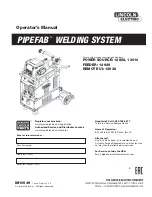
51
4.2
Shall’s and Shall Not’s for Operation
Improper operation of a hoist can create a potentially hazardous
situation which, if not avoided, could result in death or serious
injury, and substantial property damage. To avoid such a
potentially hazardous situation
THE OPERATOR SHALL:
•
NOT
lift more than rated load for the hoist.
•
NOT
operate unless load is centered under hoist.
•
NOT
use damaged hoist or hoist that is not working
properly.
•
NOT
use hoist with twisted, kinked, damaged, or
worn chain.
•
NOT
use hoist if the bottom hook is capsized
(double fall hoists - see
Section 3.2
).
•
NOT
use the hoist to lift, support, or transport
people.
•
NOT
lift loads over people.
•
NOT
apply load unless load chain is properly
seated in the load sheave (and idle sheave for hoist
with two chain falls).
•
NOT
use the hoist in such a way that could result in
shock or impact loads being applied to the hoist.
•
NOT
attempt to lengthen the load chain or repair
damaged load chain.
•
NOT
operate hoist when it is restricted from forming
a straight line from hook to hook in the direction of
loading.
•
NOT
use load chain as a sling or wrap load chain
around load.
•
NOT
apply the load to the tip of the hook or to the
hook latch.
•
NOT
apply load if binding prevents equal loading
on all load-supporting chains.
•
NOT
operate beyond the limits of the load chain
travel.
•
NOT
operate hoist with missing/damaged chain
springs, cushion rubbers, stoppers or striker plates.
•
NOT
leave load supported by the hoist unattended
unless specific precautions have been taken.
•
NOT
allow the chain, or hook to be used as an
electrical or welding ground.
•
NOT
allow the chain, or hook to be touched by a
live welding electrode.
•
NOT
remove or obscure the warnings on the hoist.
•
NOT
operate a hoist on which the safety placards
or decals are missing or illegible.
•
Be familiar with operating controls, procedures, and
warnings.
•
Make sure the unit is securely attached to a
suitable support before applying load.
•
Make sure load slings or other approved single
attachments are properly sized, rigged, and seated
in the hook saddle.
•
Take up slack carefully - make sure load is
balanced and load-holding action is secure before
continuing.
•
Make sure all persons stay clear of the supported
load.
•
Protect the hoist’s load chain from weld splatter or
other damaging contaminants.
•
Report Malfunctions or unusual performances
(including unusual noises) of the hoist and remove
the hoist from service until the malfunction or
unusual performance is resolved.
•
Make sure hoist limit switches function properly.
•
Warn personnel before lifting or moving a load.
•
Warn personnel of an approaching load.
Содержание TF2 Series
Страница 37: ...37 Figure 3 34 Adjusting the Trolley...
Страница 66: ...66 8 3 TS2 Push Trolley Parts 1 8 to 5 Ton TS2 Push Trolley 1 2 to 3 Ton TS2 Push Trolley 5 Ton Figure 8 3...
Страница 74: ...74 8 7 TF TS Geared Trolley Parts for CB Hoist 15 to 20 Ton TF TS Trolley for CB Hoist 15 to 20 Ton...
Страница 77: ...77 This Page Intentionally Left Blank...
Страница 78: ...78 8 8 TF TS Geared Trolley Parts for ER2 Hoist 15 to 20 Ton TF TS Trolley for ER2 Hoist 15 to 20 Ton...
















































